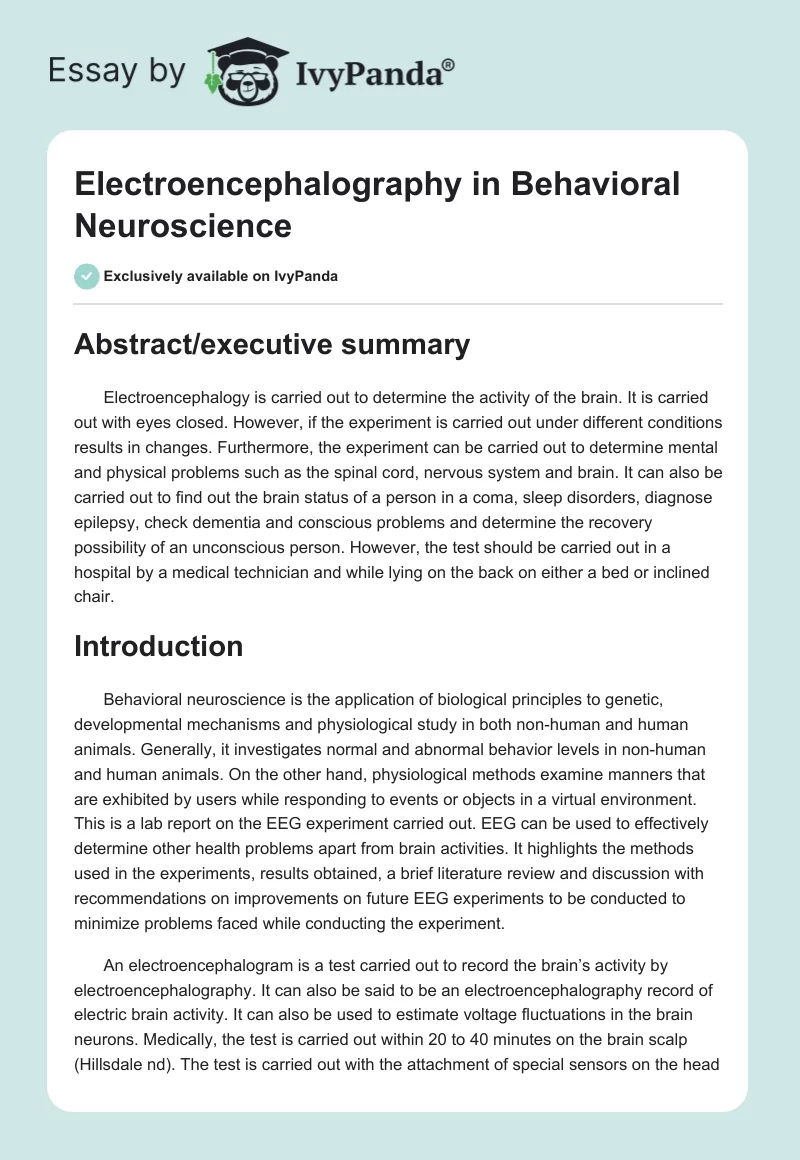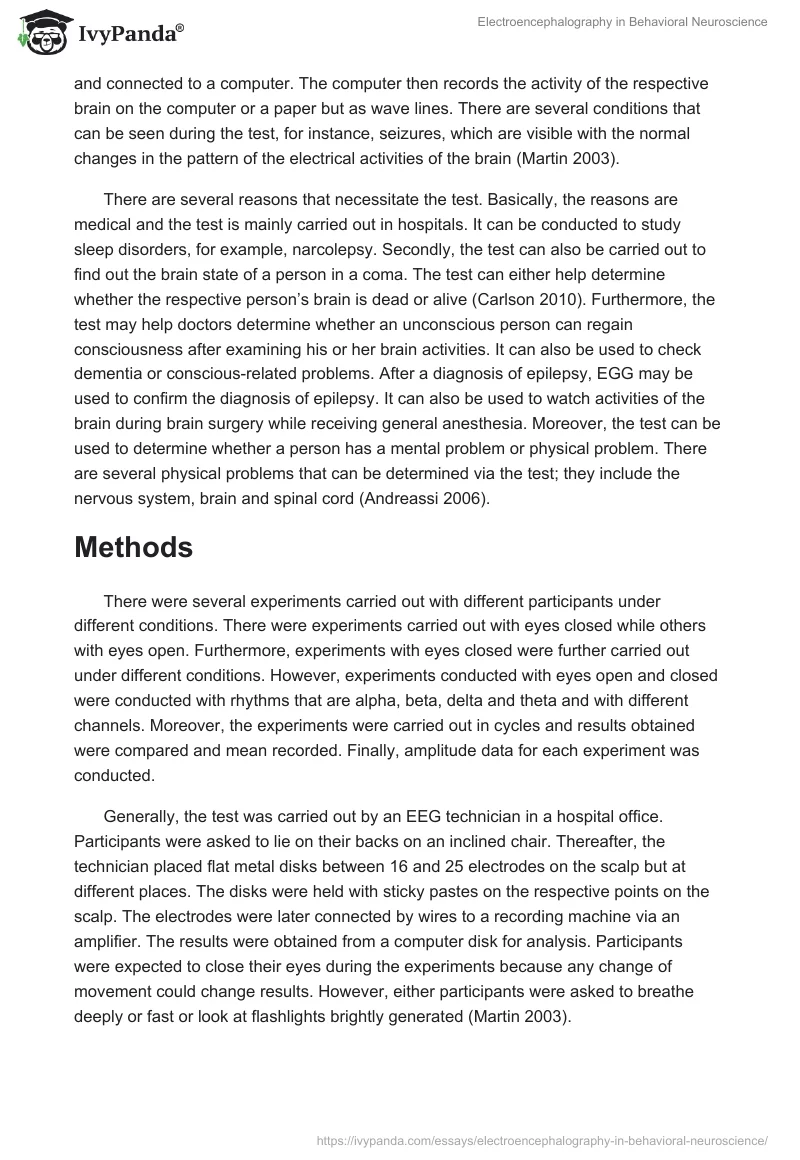Abstract/executive summary
Electroencephalogy is carried out to determine the activity of the brain. It is carried out with eyes closed. However, if the experiment is carried out under different conditions results in changes. Furthermore, the experiment can be carried out to determine mental and physical problems such as the spinal cord, nervous system and brain. It can also be carried out to find out the brain status of a person in a coma, sleep disorders, diagnose epilepsy, check dementia and conscious problems and determine the recovery possibility of an unconscious person. However, the test should be carried out in a hospital by a medical technician and while lying on the back on either a bed or inclined chair.
Introduction
Behavioral neuroscience is the application of biological principles to genetic, developmental mechanisms and physiological study in both non-human and human animals. Generally, it investigates normal and abnormal behavior levels in non-human and human animals. On the other hand, physiological methods examine manners that are exhibited by users while responding to events or objects in a virtual environment. This is a lab report on the EEG experiment carried out. EEG can be used to effectively determine other health problems apart from brain activities. It highlights the methods used in the experiments, results obtained, a brief literature review and discussion with recommendations on improvements on future EEG experiments to be conducted to minimize problems faced while conducting the experiment.
An electroencephalogram is a test carried out to record the brain’s activity by electroencephalography. It can also be said to be an electroencephalography record of electric brain activity. It can also be used to estimate voltage fluctuations in the brain neurons. Medically, the test is carried out within 20 to 40 minutes on the brain scalp (Hillsdale nd). The test is carried out with the attachment of special sensors on the head and connected to a computer. The computer then records the activity of the respective brain on the computer or a paper but as wave lines. There are several conditions that can be seen during the test, for instance, seizures, which are visible with the normal changes in the pattern of the electrical activities of the brain (Martin 2003).
There are several reasons that necessitate the test. Basically, the reasons are medical and the test is mainly carried out in hospitals. It can be conducted to study sleep disorders, for example, narcolepsy. Secondly, the test can also be carried out to find out the brain state of a person in a coma. The test can either help determine whether the respective person’s brain is dead or alive (Carlson 2010). Furthermore, the test may help doctors determine whether an unconscious person can regain consciousness after examining his or her brain activities. It can also be used to check dementia or conscious-related problems. After a diagnosis of epilepsy, EGG may be used to confirm the diagnosis of epilepsy. It can also be used to watch activities of the brain during brain surgery while receiving general anesthesia. Moreover, the test can be used to determine whether a person has a mental problem or physical problem. There are several physical problems that can be determined via the test; they include the nervous system, brain and spinal cord (Andreassi 2006).
Methods
There were several experiments carried out with different participants under different conditions. There were experiments carried out with eyes closed while others with eyes open. Furthermore, experiments with eyes closed were further carried out under different conditions. However, experiments conducted with eyes open and closed were conducted with rhythms that are alpha, beta, delta and theta and with different channels. Moreover, the experiments were carried out in cycles and results obtained were compared and mean recorded. Finally, amplitude data for each experiment was conducted.
Generally, the test was carried out by an EEG technician in a hospital office. Participants were asked to lie on their backs on an inclined chair. Thereafter, the technician placed flat metal disks between 16 and 25 electrodes on the scalp but at different places. The disks were held with sticky pastes on the respective points on the scalp. The electrodes were later connected by wires to a recording machine via an amplifier. The results were obtained from a computer disk for analysis. Participants were expected to close their eyes during the experiments because any change of movement could change results. However, either participants were asked to breathe deeply or fast or look at flashlights brightly generated (Martin 2003).
Results
There are different results that were obtained from the experiments that were carried out. On rhythm, alpha, there were 40 participants which represented 0.13 of those who closed their eyes, 0.18 of those who opened their eyes, 0.17 of those who closed their eyes on the second attempt of the experiment. Secondly, on beta there were 41channels recording 0.26 eyes closed, 0.30 eyes open and 0.30 eyes closed on the second attempt. Third, on delta there were 42 channels representing 0.37 eyes closed, 0.44 y open and 0.49 eyes closed on the second attempt.
Furthermore, a controlled data experiment with eyes closed recorded different results on each attempt. However, theta, delta, alpha and beta rhythms were still used in the experiment. During cycle one, alpha recorded 10, beta 25, theta 5.41, and delta 4.17. In cycle two, alpha recorded 11.79, beta 22.22, delta 5.00 and theta 5.41. On the other hand, cycle three recorded 9.52 on alpha, 28.57on beta, 2.41 on delta and 6.99 on theta. Generally, alpha rhythm recorded the highest mean at 10.43 followed by beta at 25.26, delta at 3.86, and the lowest mean was theta at 5.91.
Moreover, the amplitude for each data was also conducted and different results were recorded too. For example, an experiment conducted with eyes closed recorded 19.26 on EEG studded, 3.42 on alpha studded (ch40), 0.25 RMS means (ch41), but there was no alpha RMS summary and alpha RMS. Secondly, an experiment was carried out with mental arithmetic as the experimental condition, 2.56 EGG studded was recorded, 0.64 alpha studded (ch40) was recorded, 0.07 alpha RMS means was recorded and a smaller alpha RMS summary was made. Furthermore, an experiment with the condition after hypertension was conducted and different results were obtained. For instance, 2.03 as recorded on EEG studded, 0.79 alpha studded (ch40), 0.12 alpha RMS means (ch41) and alpha RMS summary was recorded as smaller. Finally, an experiment with eyes open was recorded and 299 EGG studded, 0.59 alpha studded (ch40), and 0.86 alpha RMS means (ch41) were recorded. However, the alpha RMS summary was longer as opposed to those other experiments carried with eyes closed that recorded an alpha RMS summary of smaller. However, the experiment conducted with closed eyes without any other condition recorded equal results.
Discussion
Activities of the brain vary with conditions. This has been portrayed from the results of the tests carried out. These results were obtained from a single but under different conditions hence varied results. It signifies that change of condition changes brain activity during the test. Moreover, rhythms also influence the activities of the brain. Finally, it’s true that reliable results of the tests can only be achieved when the eyes are closed and no other activities or conditions are in place.
Generally, electrical activities of the brain have a certain number of waves recorded per second. The waves are normal at different levels of consciousness, for instance, waves are high when someone is awake and slow when someone is asleep (Carlson 2010). On the other hand, abnormal results may be due to several reasons mainly affecting health status. Abnormal results may be caused by abnormal bleeding, alcohol or drug abuse, head injury, abnormal brain structure, attention problems, death of tissues due to blood flow blockage. Moreover, it can also be due to migraines, brain swelling, sleep disorders, and seizure disorders (Andreassi 2006).
Though the test procedure is safe, it may lead to other health problems or unreliable results due to the flashing lights or fast breathing during the test. These may trigger seizures among patients with seizure disorders. Moreover, removal of the paste may take some time too. Therefore, ways of avoiding seizure attacks during the test should be developed and the safe removal of the pastes.
Reference list
Andreassi, J.L. 2006, Psychophysiology: human behavior and physiological response.
Carlson, N.R. 2010, Foundations of Behavioural Neuroscience. (8th Edition), MA: Allyn& Bacon. Hillsdale, NJ: Lawrence Erlbaum Associates. Fifth edition.
Martin, G.N. 2003, Essential Biological Psychology. London: Hodder Arnold.


